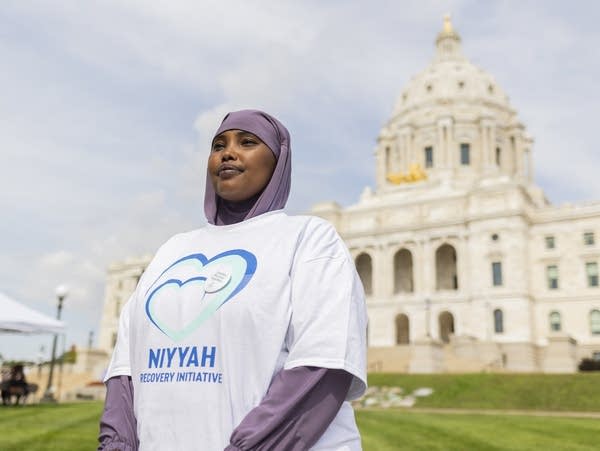Recovery awareness growing in East African community as opioid crisis takes toll

Go Deeper.
Create an account or log in to save stories.
Like this?
Thanks for liking this story! We have added it to a list of your favorite stories.
Farhia Budul gazed over the state Capitol grounds as hundreds of people stopped at booths lining the street. For Budul, the Sept. 17 Walk for Recovery was lined with hope.
“You see recovery everywhere here in the state of Minnesota,” Budul said.
Substance use disorder recovery advocates like Budul are sounding the alarm about the opioid crisis.
“The opioid epidemic has come hard and hit hard the East African community,” Budul said as she greeted passersby.
Turn Up Your Support
MPR News helps you turn down the noise and build shared understanding. Turn up your support for this public resource and keep trusted journalism accessible to all.

As Budul, a Somali American Muslim woman, began her own journey of recovery from substance use disorder, she saw a pressing need for culturally-specific services. Budul founded her nonprofit Niyyah Recovery Initiative last year.
Niyyah means “intention” in Arabic, Budul explained. She aims to educate what she describes as the backbone of the community, particularly mothers and elders, about opioids and substance use disorder in the Somali language.
“Moms are like, ‘My son or daughter died of a heart attack,’ when we know that 20-year-old playing basketball the other day had taken the wrong pill laced with fentanyl and overdosed and did not wake up,” she said.
Budul said lack of education and stigma is attached to the idea of addiction in her culture, which is why she chooses to “recover out loud.”

The problem is in every Minnesota community. The state reported record drug overdose deaths in 2021. The increasing prevalence of fentanyl is thought to be a contributing factor. While the Minnesota Department of Health said it does not keep data on overdoses in the East African communities currently, the state does keep track of the numbers by groups more broadly.
In the most recent numbers from 2019, African Americans were almost two times more likely to die of a drug overdose than whites. Native Americans were seven times more likely to die of drug overdose than whites.
Pearl Evans, a prevention program administrator for the state health department, works on culturally-specific services for Black Minnesotans. Evans has seen an encouraging shift among the older generation during the pandemic.
“They are more open to having this conversation, to receive the information so they can be prepared to administer naloxone,” Evans said.
Naloxone, also called Narcan, rapidly reverses an opioid overdose, and can be administered in a nasal spray.
Like Budul, Yussuf Shafie is one of the pioneers of culturally-specific services for the East African community. Shafie, the CEO and treatment director at the Alliance Wellness Center in Bloomington, Minn., said he has also seen significant changes in awareness and acceptance of substance use disorders, partly because of the desperation of the families touched by the opioid crisis.

“2015 was more like alcohol, marijuana, cocaine,” Shafie said. “2018, 2019, 2020, [it was] opioids and fentanyl.” He added that fentanyl seems to comprise almost all of the cases he’s seeing.
Shafie’s goal is to serve as a bridge between youth and their families in a rapidly changing landscape.
“It’s a different generation with social media and technology,” Shafie said. “Drugs are easily accessible nowadays and it’s just really unfortunate.”
Minnesota Bureau of Criminal Apprehension Superintendent Drew Evans said law enforcement is also working to curb an increase of importation of fentanyl across the southern U.S. border. Evans said fake oxycodone pills that can contain fentanyl have become among the most common seizures.
“In 2021, for example, we were seeing about an average of 100 cases involving fentanyl per month coming into our BCA laboratories across the state,” the BCA superintendent said. “This year we are on pace at 120 cases per month, so you see a significant increase we are looking at.”
Last year, Minnesota averaged more than three people dying every day from an overdose of any drug type and the state reported a larger percentage increase in overdose deaths in greater Minnesota than in the seven-county Twin Cities area.
September is National Recovery Month. Farhia Budul said it will take everyone’s efforts year-round to fight the opioid crisis.
“Addiction does not discriminate, it does not have a color,” Budul said. She added that for future Recovery Walks, “I hope to see in the next few years more East African and more BIPOC communities coming out to the state Capitol.”




